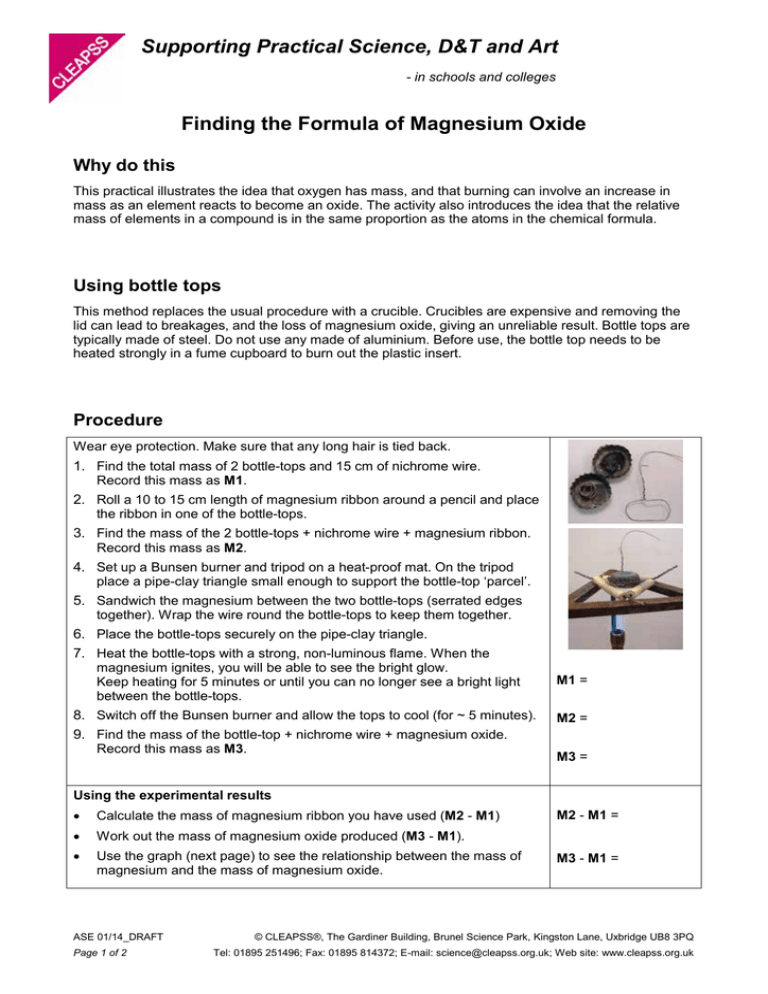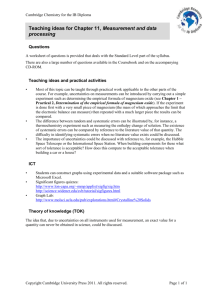Supporting Practical Science, D&T and Art Why do this
advertisement

Supporting Practical Science, D&T and Art - in schools and colleges Finding the Formula of Magnesium Oxide Why do this This practical illustrates the idea that oxygen has mass, and that burning can involve an increase in mass as an element reacts to become an oxide. The activity also introduces the idea that the relative mass of elements in a compound is in the same proportion as the atoms in the chemical formula. Using bottle tops This method replaces the usual procedure with a crucible. Crucibles are expensive and removing the lid can lead to breakages, and the loss of magnesium oxide, giving an unreliable result. Bottle tops are typically made of steel. Do not use any made of aluminium. Before use, the bottle top needs to be heated strongly in a fume cupboard to burn out the plastic insert. Procedure Wear eye protection. Make sure that any long hair is tied back. 1. Find the total mass of 2 bottle-tops and 15 cm of nichrome wire. Record this mass as M1. 2. Roll a 10 to 15 cm length of magnesium ribbon around a pencil and place the ribbon in one of the bottle-tops. 3. Find the mass of the 2 bottle-tops + nichrome wire + magnesium ribbon. Record this mass as M2. 4. Set up a Bunsen burner and tripod on a heat-proof mat. On the tripod place a pipe-clay triangle small enough to support the bottle-top ‘parcel’. 5. Sandwich the magnesium between the two bottle-tops (serrated edges together). Wrap the wire round the bottle-tops to keep them together. 6. Place the bottle-tops securely on the pipe-clay triangle. 7. Heat the bottle-tops with a strong, non-luminous flame. When the magnesium ignites, you will be able to see the bright glow. Keep heating for 5 minutes or until you can no longer see a bright light between the bottle-tops. 8. Switch off the Bunsen burner and allow the tops to cool (for ~ 5 minutes). 9. Find the mass of the bottle-top + nichrome wire + magnesium oxide. Record this mass as M3. M1 = M2 = M3 = Using the experimental results · Calculate the mass of magnesium ribbon you have used (M2 - M1) · Work out the mass of magnesium oxide produced (M3 - M1). · Use the graph (next page) to see the relationship between the mass of magnesium and the mass of magnesium oxide. ASE 01/14_DRAFT Page 1 of 2 M2 - M1 = M3 - M1 = © CLEAPSS®, The Gardiner Building, Brunel Science Park, Kingston Lane, Uxbridge UB8 3PQ Tel: 01895 251496; Fax: 01895 814372; E-mail: science@cleapss.org.uk; Web site: www.cleapss.org.uk The variation of the mass of magnesium oxide with the mass of magnesium The green line corresponds to the formula Mg20. The blue line corresponds to the formula Mg0. The red line corresponds to the formula Mg02. Extension Magnesium reacts with nitrogen to form magnesium nitride (Mg3N2) which reacts with water to produce ammonia which changes moist red litmus to blue. Add the solid in the bottle tops to a small container (a vial) and place damp red litmus paper over the top. ASE 01/14_DRAFT Page 2 of 2 Remove the paper and add boiling water to the vial. Replace the litmus. © CLEAPSS®, The Gardiner Building, Brunel Science Park, Kingston Lane, Uxbridge UB8 3PQ Tel: 01895 251496; Fax: 01895 814372; E-mail: science@cleapss.org.uk; Web site: www.cleapss.org.uk






